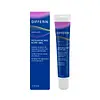What's inside
What's inside
 Key Ingredients
Key Ingredients

 Benefits
Benefits

 Concerns
Concerns

No concerns
 Ingredients Side-by-side
Ingredients Side-by-side

Dimethicone 2%
EmollientWater
Skin ConditioningCetearyl Alcohol
EmollientPentylene Glycol
Skin ConditioningC12-15 Alkyl Benzoate
AntimicrobialDicaprylyl Carbonate
EmollientGlycerin
HumectantArachidyl Alcohol
EmollientAlcohol
AntimicrobialAloe Barbadensis Leaf Juice
Skin ConditioningCyclopentasiloxane
EmollientBehenyl Alcohol
EmollientCyclohexasiloxane
EmollientArachidyl Glucoside
EmulsifyingAllium Cepa Bulb Extract
Skin ConditioningParfum
MaskingCetearyl Glucoside
EmulsifyingTocopheryl Acetate
AntioxidantHydroxyethyl Acrylate/Sodium Acryloyldimethyl Taurate Copolymer
Emulsion StabilisingHydroxyethylcellulose
Emulsion StabilisingGlycine
BufferingPanthenol
Skin ConditioningHydrolyzed Collagen
EmollientPEG-400
Emulsion StabilisingPolysorbate 60
EmulsifyingSorbitan Isostearate
EmulsifyingCitric Acid
BufferingSodium Hydroxide
BufferingAlanine
MaskingArginine Hcl
Skin ConditioningAspartic Acid
MaskingGlucose
HumectantGlutamic Acid
HumectantIsopropyl Alcohol
SolventLeucine
Skin ConditioningLysine Hcl
Skin ConditioningMannitol
HumectantSodium Lactate
BufferingSorbitol
HumectantTromethamine
BufferingValine
MaskingPotassium Sorbate
PreservativeSodium Benzoate
MaskingTocopherol
AntioxidantBis(Tripeptide-1) Copper Acetate
Skin ConditioningHistidine
HumectantHydrolyzed Soy Protein
HumectantIsoleucine
Skin ConditioningPhenylalanine
MaskingTyrosine
MaskingDimethicone 2%, Water, Cetearyl Alcohol, Pentylene Glycol, C12-15 Alkyl Benzoate, Dicaprylyl Carbonate, Glycerin, Arachidyl Alcohol, Alcohol, Aloe Barbadensis Leaf Juice, Cyclopentasiloxane, Behenyl Alcohol, Cyclohexasiloxane, Arachidyl Glucoside, Allium Cepa Bulb Extract, Parfum, Cetearyl Glucoside, Tocopheryl Acetate, Hydroxyethyl Acrylate/Sodium Acryloyldimethyl Taurate Copolymer, Hydroxyethylcellulose, Glycine, Panthenol, Hydrolyzed Collagen, PEG-400, Polysorbate 60, Sorbitan Isostearate, Citric Acid, Sodium Hydroxide, Alanine, Arginine Hcl, Aspartic Acid, Glucose, Glutamic Acid, Isopropyl Alcohol, Leucine, Lysine Hcl, Mannitol, Sodium Lactate, Sorbitol, Tromethamine, Valine, Potassium Sorbate, Sodium Benzoate, Tocopherol, Bis(Tripeptide-1) Copper Acetate, Histidine, Hydrolyzed Soy Protein, Isoleucine, Phenylalanine, Tyrosine
Water
Skin ConditioningDimethicone
EmollientDimethicone Crosspolymer
Emulsion StabilisingCaprylic/Capric Triglyceride
MaskingBis-PEG-12 Dimethicone
EmollientGlyceryl Oleate Citrate
EmulsifyingEthoxydiglycol
HumectantBakuchiol
AntimicrobialDextran
Hippophae Rhamnoides Fruit Oil
Skin ProtectingHippophae Rhamnoides Seed Oil
Skin ProtectingAsiatic Acid
Skin ConditioningAsiaticoside
AntioxidantRosa Rubiginosa Seed Oil
EmollientButylene Glycol
HumectantHydrogenated Ethylhexyl Olivate
EmollientPhenoxyethanol
PreservativeAcrylates/C10-30 Alkyl Acrylate Crosspolymer
Emulsion StabilisingCitric Acid
BufferingSodium Hydroxide
BufferingTocopheryl Acetate
AntioxidantEthylhexylglycerin
Skin ConditioningDisodium EDTA
Squalane
EmollientMadecassic Acid
Skin ConditioningTripeptide-1
Skin ConditioningWater, Dimethicone, Dimethicone Crosspolymer, Caprylic/Capric Triglyceride, Bis-PEG-12 Dimethicone, Glyceryl Oleate Citrate, Ethoxydiglycol, Bakuchiol, Dextran, Hippophae Rhamnoides Fruit Oil, Hippophae Rhamnoides Seed Oil, Asiatic Acid, Asiaticoside, Rosa Rubiginosa Seed Oil, Butylene Glycol, Hydrogenated Ethylhexyl Olivate, Phenoxyethanol, Acrylates/C10-30 Alkyl Acrylate Crosspolymer, Citric Acid, Sodium Hydroxide, Tocopheryl Acetate, Ethylhexylglycerin, Disodium EDTA, Squalane, Madecassic Acid, Tripeptide-1
 Reviews
Reviews

Ingredients Explained
These ingredients are found in both products.
Ingredients higher up in an ingredient list are typically present in a larger amount.
Citric Acid is an alpha hydroxy acid (AHA) naturally found in citrus fruits like oranges, lemons, and limes.
Like other AHAs, citric acid can exfoliate skin by breaking down the bonds that hold dead skin cells together. This helps reveal smoother and brighter skin underneath.
However, this exfoliating effect only happens at high concentrations (20%) which can be hard to find in cosmetic products.
Due to this, citric acid is usually included in small amounts as a pH adjuster. This helps keep products slightly more acidic and compatible with skin's natural pH.
In skincare formulas, citric acid can:
While it can provide some skin benefits, research shows lactic acid and glycolic acid are generally more effective and less irritating exfoliants.
Most citric acid used in skincare today is made by fermenting sugars (usually from molasses). This synthetic version is identical to the natural citrus form but easier to stabilize and use in formulations.
Read more about some other popular AHA's here:
Learn more about Citric AcidDimethicone is a type of synthetic silicone created from natural materials such as quartz.
What it does:
Dimethicone comes in different viscosities:
Depending on the viscosity, dimethicone has different properties.
Ingredients lists don't always show which type is used, so we recommend reaching out to the brand if you have questions about the viscosity.
This ingredient is unlikely to cause irritation because it does not get absorbed into skin. However, people with silicone allergies should be careful about using this ingredient.
Note: Dimethicone may contribute to pilling. This is because it is not oil or water soluble, so pilling may occur when layered with products. When mixed with heavy oils in a formula, the outcome is also quite greasy.
Learn more about DimethiconeSodium Hydroxide is also known as lye or caustic soda. It is used to adjust the pH of products; many ingredients require a specific pH to be effective.
In small amounts, sodium hydroxide is considered safe to use. However, large amounts may cause chemical burns due to its high alkaline.
Your skin has a natural pH and acid mantle. This acid mantle helps prevent harmful bacteria from breaking through. The acid mantle also helps keep your skin hydrated.
"Alkaline" refers to a high pH level. A low pH level would be considered acidic.
Learn more about Sodium HydroxideTocopheryl Acetate is AKA Vitamin E. It is an antioxidant and protects your skin from free radicals. Free radicals damage the skin by breaking down collagen.
One study found using Tocopheryl Acetate with Vitamin C decreased the number of sunburned cells.
Tocopheryl Acetate is commonly found in both skincare and dietary supplements.
Learn more about Tocopheryl AcetateWater. It's the most common cosmetic ingredient of all. You'll usually see it at the top of ingredient lists, meaning that it makes up the largest part of the product.
So why is it so popular? Water most often acts as a solvent - this means that it helps dissolve other ingredients into the formulation.
You'll also recognize water as that liquid we all need to stay alive. If you see this, drink a glass of water. Stay hydrated!
Learn more about Water